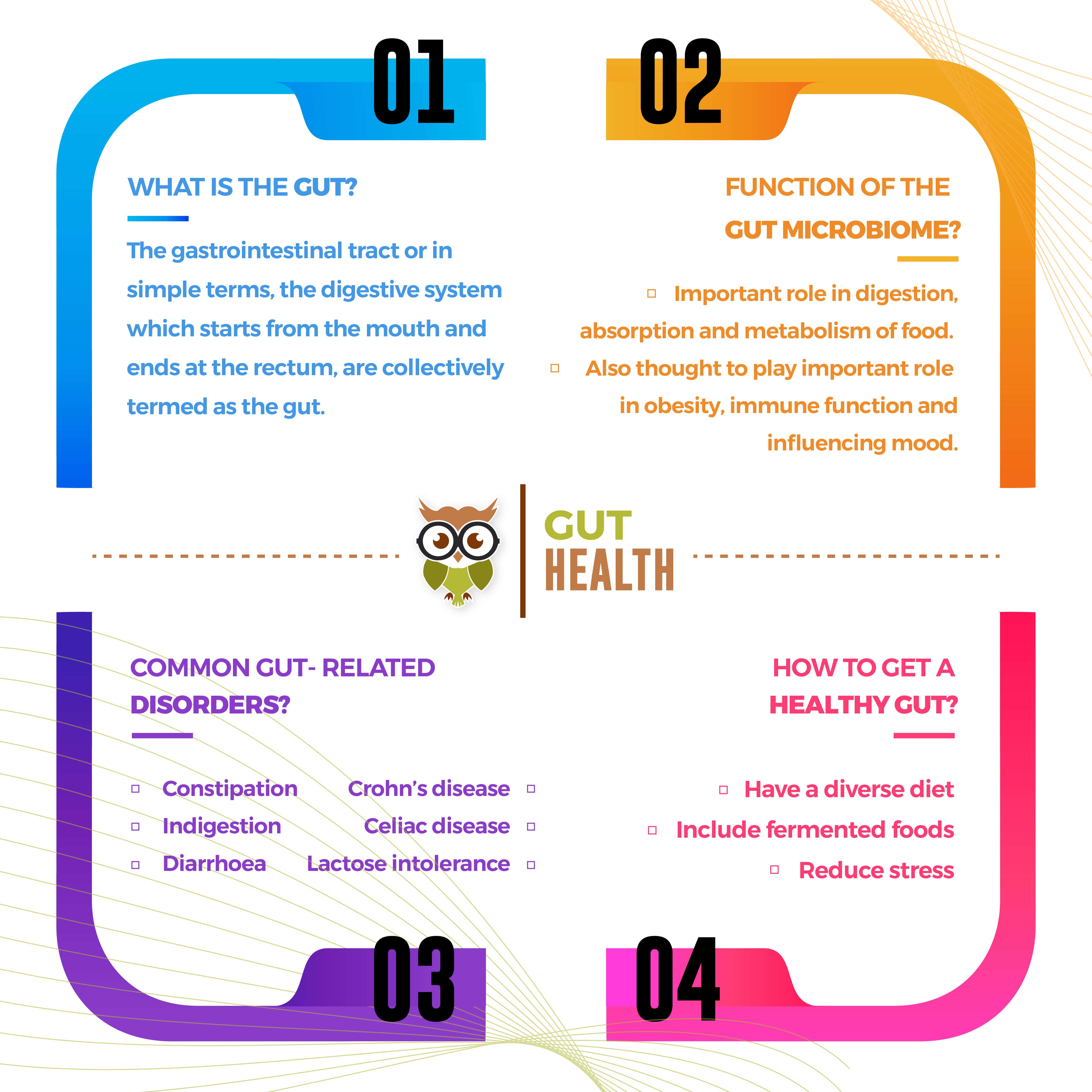Gut Health
Gut health is currently the new buzzword in the health and fitness industry. Products claiming to improve your gut and its function are slowly increasing. This might make you wonder what the fuss is all about! Gut microbes, microbiota, microbiome… What do these terms mean? Why is the gut so important? Read on to find out!

What is the gut and gut microbiota?
The gastrointestinal tract or in simple terms, the digestive system which starts from the mouth and ends at the rectum, are collectively termed as the gut. However, what people usually refer to when they use the term ‘gut’ is the intestines.
The gut, all the way from the mouth to the rectum contain a number of microorganisms (also called microbes) that are tiny microscopic organisms which are not visible to the naked eye. Microbiota refers to all the microorganisms living in the same environment, while microbiome refers to all genes of these microbes. So, the gut microbiota refers to the large community of microbes that reside in the gut.
What is the function of the gut microbiome?
The gut microbiota plays an important role in digestion, absorption and metabolism of food (1). Beyond this, the gut bacteria are also thought to play an important role in obesity (1), immune function (2) and also influencing mood (3) . In fact, our gut bacteria is said to have an impact on most of our physiological functions, directly or indirectly (2). While the research around the gut microbiota is ongoing, it is clear that it is a key factor in several aspects of the body’s optimal functioning.
What are the common gut related disorders and why does it occur?
In certain situations (for example, a disease condition) the microbes that reside in your gut can be disrupted. This will be different from the microbe community that was present when your body was healthy. This is termed as dysbiosis (2). Dysbiosis can be caused by change in eating habits, bowel movements and even medications taken when one is ill. (2). However it is to note that what changes in the microbiota are helpful or not is still being looked into.
Some of the most common gut related disorders you would have come across are constipation, indigestion and diarrhoea. However, conditions like Irritable Bowel Syndrome (IBS), Crohn’s disease, Celiac disease, lactose intolerance and colitis are also gut related.
What can I do for a healthy gut?
The following simple tips can be incorporated in order to ensure your gut microbes are functioning well in order to support your body’s optimal functioning;
Diverse diet: As mentioned before, a large and diverse community of microbes reside in our gut. To support these microbes, our diet needs to be equally diverse. Our food serves as substrates for these microbes to thrive. It is clear that the diversity of our diet determines the diversity and richness of the gut microbiota (4). The increasing number of fad diets is also an issue of concern as it encourages elimination of food groups, which in turn affect the diversity of the gut microbiota (5). Fibre intake and polyphenols also play key role in shaping the microbiome. Low intake of fibre paired with high fat and sugar intake may reduce certain microbe groups in the gut (6). Polyphenols are found in foods like tea, chocolate, spice, seasonings,herbs and even fruits and vegetables. Interactions between polyphenols and the gut microbes can also impact health (7).
What can you do? Ensure your diet is diverse by varying the foods you eat on a daily basis. Consume fibre rich food such as whole grains, lentils/legumes, fruits and vegetables. Aim for at least 25-30g of fibre a day. Fruits and vegetables, also ering rich in polyphenols provide an additional benefit.
Fermented foods: Fermentation is a natural process by which bacteria break down substances into simpler forms. Examples of fermented food are kimchi, yoghurt, kefir among several others. These are commonly termed as ‘probiotics’ since they contain live cultures of microorganisms in them! While the research on probiotics is still ongoing, they do seem to show promising effects on enriching the existing gut flora (8). Why not give this a go?
Stress: This is something that affects each one of us on a day to day basis. While everyone knows that extreme stress is unhealthy, little do we know that stress also affects the diversity of microbes in the gut (9). Yes, you heard that right! While we do know how stress negatively affects several aspects of health, it also has an impact of the tiny bugs living in your gut.
In conclusion, gut health is a growing area of research. While there are a number of questions unanswered, the field seems vast and promising. It is clear that the gut plays an important role in several aspects of human health. Hence, it is necessary for us to understand this and nourish the gut by living a healthy lifestyle.
REFERENCES:
1) Ursell L, Metcalf J, Parfrey L, Knight R. Defining the human microbiome. Nutrition Reviews. 2012;70(Suppl 1):S38-S44.
2) Shreiner AB, Kao, JY, Young, VB. The gut microbiome in health and disease. Current Opinion Gastroentology. 2015;31(1):69-75
3) Dash S, Clarke G, Berk M, Jacka F. The gut microbiome and diet in psychiatry: Focus on depression. Current Opinion in Psychiatry. 2015;28(1):1-6.
4) Makki K, Deehan E, Walter J, Bäckhed F. The Impact of Dietary Fiber on Gut Microbiota in Host Health and Disease. Cell Host & Microbe. 2018;23(6):705-715.
5) Heiman M, Greenway F. A healthy gastrointestinal microbiome is dependent on dietary diversity. Molecular Metabolism. 2016;5(5):317-320.
6) Sonnenburg E, Sonnenburg J. Starving our Microbial Self: The Deleterious Consequences of a Diet Deficient in Microbiota-Accessible Carbohydrates. Cell Metabolism. 2014;20(5):779-786.
7) Ozdal T, Sela D, Xiao J, Boyacioglu D, Chen F, Capanoglu E. The Reciprocal Interactions between Polyphenols and Gut Microbiota and Effects on Bioaccessibility. Nutrients. 2016;8(2):78.
8) Bell V, Ferrão J, Pimentel L, Pintado M, Fernandes T. One Health, Fermented Foods, and Gut Microbiota. Foods. 2018;7(12):195.
9) Konturek PC,Brzozowski T, Konturek SJ. Stress and the gut: pathophysiology, clinical consequences, diagnostic approach and treatment options. Journal of Physiology and Pharmacology. 2011;62(6):591-599.


